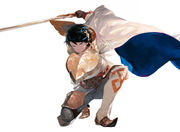During the 4th century, the Lands of the Selkie were a country much unlike the Free Lands of today (or the Lands of the Selkie in 1300, for that matter). In historic periodization, it falls into the Age of the High Kings.
Important occassions of that period include, but are not limited to, the War of the Three High Kings from 319 to 338, .
Everyday Life
It is suspected, that the popular saying of neither plow nor sword caring, if the hand leading them was strong or soft, originally came from that time.
Administration and Rulership
In Theory
In theory, up to the last years of the 4th century, the High King ruled over a majority of the Western and South Western Mainland, especially the Mór-Land, the Trossach and the White Cliffs.
The Great Woods, at the time, were past a sort-of frontier area along the Coill River, reaching well past today's borders into the Baile. Although several High Kings, including Fiona the Architect, tried to extend the influence of the High King northward, into the Cloch Mountains (a 'frontier' in its own right) and Silver Mountains, as well as along the shores of the Silver Bay and even further north to the Icy Shore, the majority of these operations were met with resistance. It took until the 5th century, with the marriage of Ribín Gorm to the Last High King, that the High King to extend and stabilize his influence on the Baile and especially Bodmin (although Princess Aife, the mother of Áed the Hunter, was the daughter of the King of Caorasanna, his early death in battle in 338 did not exactly help matters much).
Aside from his own lands, the High King had a number of smaller, local magnates, usually referred to as Kings, under him, who paid tribute in one form or the other, usually in the form of agrarian products or goods. These Kings also stood by the High King in case of armed conflict, usually with their own musters, and upheld law and order in their territories, especially among the trading routes. Outside of this tributary system, local magnates ruled over their areas more or less independently, although many tried to align themselves with the High King as an ally to have a strong power at the back - the frequency of these pacts and alliances varied greatly with the presence and severity of internal struggles within the High Kings' domain, the High King's reliability and the ambitions of the Kings and their neighbours.
Aside from the Kings, the High King also had a number of liegemen under him, who tilled their own tenures and did not have to pay taxes - in exchange, these liegemen provided the High King with troops, depending on the size of their tenure. Usually, these liegemen were bound to the High King by said tenure and, although rarely, by familial ties.
As additional political forces, the Cities and Towns, the Clans, the Elder Council and the Orders existed.
While the construction of the Old Traveling Roads would not begin until 1060, there was a system of fortified roads in place with regular inns and way-fortresses, which formed a basis of overland commerce of the Selkie of the time. Around Lake Mór, banditry was not far spread, but the further one went into the periphery, away from the lake and from the Mór-River, the more widespread it became.
In practical application
List of High Kings of the 4th century
- Cormac, of Louth Descent (ruled 279 - 301).
- Fiacha the Writer (ruled 302 - 310).
- Niall, of Westmeath Descent (ruled 310 - 338).
- Áed the Hunter (305-338, ruled from 321, allowed the foundation of the Orders in 325).
- Snechta the Singer (338 - 350).
- Slaine, of Cork Descent (350 - 361).
- Fiona the Architect (363 - 389).
- Fíachu, of Sligo Descent (389 - 409).
Religion
Economy
In the 4th century, Selkie-Economy was very much reliant on agrarian village structures, with 'industry', in the form of crafts took a far-behind second. It is estimated, that between one and two million people lived in the entire Mainland during that time, with around three quarters of them living in the lands, which belonged to the High King.
Well over 80 percent of the populations were farmers of various descriptions, the majority of which were Unfree Men, who did not own the ground they tilled, but who tilled it for someone else (as opposed to Free Men, who owned the ground or either tilled it themselves or leased it to Unfree Men) or farmhands of various descriptions. Farmhands, in fact, were on the bottom-rung of society, with the notable exception of beggars above them. Most of the smaller farms produced for sustenance,
Ranching was another important part of the agrarian economy.
Trade
Dress

Dress of the 4th century and with a typical sword of the time.
War and Peace
The High King's Muster
The High King could rely on his liegemen to provide him with troops and material, which formed the standing core for his armies. The Kings were less reliable, but still an important factor. Additionally, every free man, who owned and tilled more then five hooves of land, around sixty hectars, could be drafted for service, while free men, who owned between two and five hooves had to align themselves with their neighbours in order to finance one of their own as a soldier and those with less then two hooves could not be asked to join a campaign. Meanwhile, free men who owned more then 100 cows, could be drafted as well. Those free men, who owned and tilled more then ten hooves, or 120 hectars, had to do their military service with the cavalry or finance the equipment of several soldiers. Alternatively, if a free man could not leave his home, he could be exempted for a certain sum of money or goods.
While this sounded like an impressive army in the making, the High King, as records from 349, the last year of High King Snechta the Singer, show, could rely on an army of 250 liegemen and their retainers, a form of the Lance before it became the standard. This professional core of the High King's Army amounted to a total of around 1,500 men, 250 of which were heavy cavalry, 250 of which were light cavalry, 750 of which were infantry of various descriptions, and 250 of which were camp followers, usually servants of the liegemen.
In addition to this standing core, called the Half-Muster, the High Kings could also call for the Full Muster or High King's Muster. This included, aside from the liegemen, all free men from a given territory, as well as contingents from the local Kings, cities and towns - however, the latter three were voluntary formations, which not always rushed to arms, but made their participation dependent on certain favours. Free Men, meanwhile, had little other choice then to participate or to pay. The Orders and with them the Cults were also voluntary in their participation.
Records from 349, and the Mustering of the High King's Muster of Fort Stone, show, that the High King had to exempt the City from taxes for three years to gain their support against Clochite Mountain Raiders.
The Orders

Enya, of Claimhteoir, the First Swordmaiden, in her Armour.
The 4th century was the time, when women first made their presence known directly on the battlefield. Before, they were mostly relegated to the rear of any army, into the train, tending to wounded, horses, soldiers and a few other things.
In the 4th century, in 325, however, the Cults saw it fit to establish their own small forces, the Orders, which soon found the approval of High King Áed the Hunter, under certain provisions.
The most important orders of the 4th century were the Swordmaidens of Carman Fea and the Arrowmaidens of Lodan Lir, both making quite an impression onto the enemy due to their light armour, an early form of the Geansai, and their abilities with both the sword and the bow respectively.
Weapons and Armour

High King Áed the Hunter, armed and ready.
Many of the weapons and armour of the time were predecessors of the weapons and armour used to this day, although some developments were altered or abandoned. One example for the latter would be scale armour, which was, gradually, replaced in the 4th century by lamellar and partially plate, which would really take off in the 10th century, developing slowly but surely into the familiar half-cuirasses.
Chainmail was developed in the 4th century as well, but it was very expensive and rarely used due to that. However, its effectiveness was undoubted.
Quilted armour also enjoyed popularity, especially amongst the Spiorad Ainmhithe and amongst the poor, as it was cheap and easily produced.